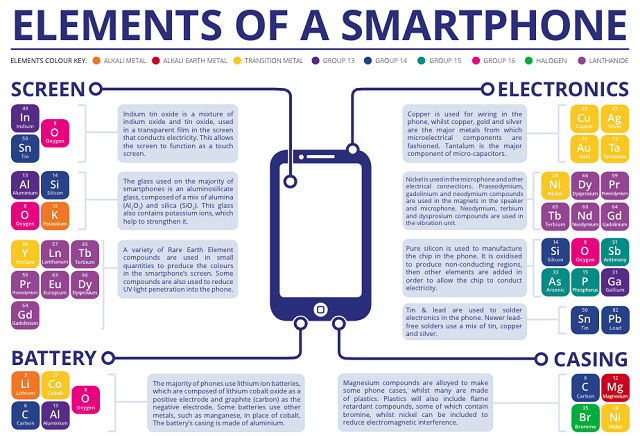
Image courtesy: Compound Interest
A new white paper titled ‘The Efficient Use of Elements’ urges researchers to develop alternative materials and novel methods to technology development to address the issue of scarcity in the supply of critical elements used in a range of products from electric motors, to hybrid cars and the iPhone.
The white paper, a product of the fifth Chemical Sciences and Society Summit (CS3), is a subject of discussion at the American Chemical Society's (ACS) 248th National Meeting & Exposition.
Technological advancements achieved in the past few decades rely largely on the mining and application of scarce elements. Smartphones, for instance, are made from rare elements such as copper, platinum and indium.
Indium is a minor by-product of zinc refining, so its supply is dictated not by the demand for indium but by the (much larger, but less rapidly expanding) demand for zinc. This makes it very difficult to increase the indium supply.
Dr. Susannah Scott - University of California
Other rare materials such as rhodium and palladium are used in pharmaceutical manufacture.
Dr. Susannah Scott, one of the researchers behind the study, discussed the implications of their findings exclusively with AZoM.com. When asked about the elements which are of particular concern, Susannah said, "Indium, used in indium tin oxide, as the transparent conductive coating for glass touchscreen displays. Indium is a minor by-product of zinc refining, so its supply is dictated not by the demand for indium but by the (much larger, but less rapidly expanding) demand for zinc. This makes it very difficult to increase the indium supply,".
Susannah went on to talk about other elements at risk "heavy rare earths used in phosphors that create colors in the display (such as dysprosium, Dy), as well as in magnets used in the microphone, speaker and vibration unit (such as neodymium, Nd). The heavy rare earths come mostly from laterite clays mined in southern China."
The responsible manufacture of sophisticated devices is becoming a challenging task due to the scarcity of these rare materials.
Developing alternative materials for these scarce elements is one of the solutions offered in the white paper, suggesting that extensive research on alternative materials must be prioritized.
So what are some of the short- and long-term solutions to this problem? "A short-term solution is to complement the extraction of critical elements from natural ores with extraction from discarded materials. This is called urban mining, and in some cases the concentrations of critical elements can be higher in discarded devices than in the natural ores," Susannah explained.
"Recovery/recycling is often challenging from an economic perspective because the amounts are still very small, and the total composition can be very complex. In addition, recycling is limited by our ability to collect used materials."
Susannah then highlighted potential long-term solutions to this problem, "In the long term, we need to develop alternative materials based on Earth-abundant elements (such as conducting organic displays, and base metal phosphors). This will require major research efforts because the performance of the alternatives is often lower than the current materials.".
Failing to find a solution would limit technology developments, leading to economical, political and social challenges globally. Many different approaches are discussed in the white paper to address the material scarcity problem.
Serious disruptions can be avoided only with a multi-faceted, global strategy. Recovery and recycling will be the key component of any strategy as these materials are scarce elements. Moreover, the entire use cycle of these critical resources needs to be considered, starting from mining and production to recovery and recycling.
Many different white papers and studies were presented at the ACS 248th National Meeting & Exposition. A particularly interesting study highlighted the potential use of hemp bast fibers in supercapcitors rather than the wonder material graphene.